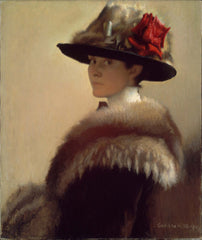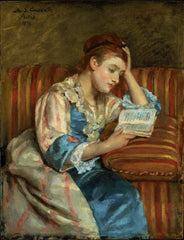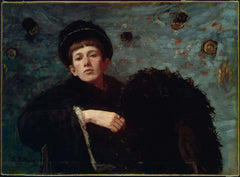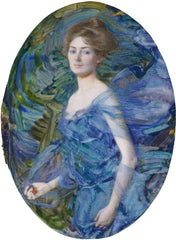“I predict an hour when the term ‘Women in Art’ will be as strange sounding a topic as the title ‘Men in Art’ would be now” remarked the well-known painter Cecilia Beaux in 1915. That day has yet to occur, despite Beaux’s considerable accomplishments and those of the many hundred American women artists of her own and subsequent generations. That statement is emblematic of American women artists seeking a literal and metaphorical studio in which to practice their craft. While this problem was not unique to Boston, the city saw perhaps the largest concentration of women artists in the country, and among the most accomplished.
Gretchen Woodman Rogers, Woman in a Fur Hat
Like her friend and colleague Lilian Westcott Hale, Gretchen Woodman  Rogers studied at the School of the Museum of Fine Arts with Edmund Tarbell. Tarbell said that Rogers was “the best pupil I ever had . . . a genius.” She became an accomplished figure painter, much admired during her own time but little known today. She apparently abandoned her career during the 1930s, unable to earn her living as an artist during the Depression and unwilling to paint only as an amateur.
Rogers studied at the School of the Museum of Fine Arts with Edmund Tarbell. Tarbell said that Rogers was “the best pupil I ever had . . . a genius.” She became an accomplished figure painter, much admired during her own time but little known today. She apparently abandoned her career during the 1930s, unable to earn her living as an artist during the Depression and unwilling to paint only as an amateur.
Something of Rogers’s professional determination might be gleaned from Woman in a Fur Hat. While it was never exhibited as such, contemporary critics noted that this image was her own self-portrait. The figure’s steady, appraising gaze is typical of such works, which are most often made by looking into a mirror. But Rogers gives the viewer no hint that the woman she depicts is an artist, for she wears the elegant winter hat and fur wrap of a well-bred lady and there are no brushes or palette to be seen. Despite her apparent modesty, Rogers’s likeness is a tour-de-force of painting. She includes a variety of textures and materials—velvet, wool, fur, and flesh—each one rendered with absolute verisimilitude. Like many of her Boston School colleagues, Rogers respected the long history and tradition of painting. Her thoughtful, unpretentious woman, surrounded by a gentle, radiant light, is reminiscent of Johannes Vermeer’s Girl with a Pearl, one of the Dutch artist’s most mesmerizing pictures. By referring to this well-known painting in her image of a contemporary woman, Rogers links past and present, projecting an exquisite and timeless impression of strength and confidence.
Mary Cassatt, Mrs. Duffee Seated on a Striped Sofa, Reading
Mary Stevenson Cassatt, raised near Pittsburgh and first trained as a painter in Philadelphia, became nineteenth-century America’s most modern painter. Like many of her contemporaries, Cassatt felt that her artistic education in the United States was inadequate, and she traveled to Europe soon after the Civil War. She studied in both Italy and France, and by 1873 she had made Paris her home. While most of her compatriots were proud of the education they received in the art schools of the French capital, Cassatt soon tired of the conservative approach taught in those academies and perpetuated by the exhibitions they organized. She felt strongly that painting needed to break free of old methods and adapt to the modern world.
in the United States was inadequate, and she traveled to Europe soon after the Civil War. She studied in both Italy and France, and by 1873 she had made Paris her home. While most of her compatriots were proud of the education they received in the art schools of the French capital, Cassatt soon tired of the conservative approach taught in those academies and perpetuated by the exhibitions they organized. She felt strongly that painting needed to break free of old methods and adapt to the modern world.
Cassatt found the answer to her demand for a new kind of painting in the work of the Impressionists, a small circle of independent French artists. She approved of their disdain for juried exhibitions and soon adopted their experimental techniques and their preference for images of contemporary life. In 1877 Edgar Degas invited her to show her work with the group. Cassatt thus became one of only three women, and the only American, ever to join the French Impressionists.
Cassatt is especially admired for her domestic scenes—of women reading, knitting, taking tea, and caring for their children. The activities they depict fall within the normal routine for Cassatt’s sex and class. Yet the painter’s insistence upon representing such episodes from the modern world (even a sheltered segment of it), her dislike for narrative, and her devotion to surface arrangement and color, mark Cassatt’s dedication to the most advanced artistic principles of her day.
Ellen Day Hale, Self Portrait
Ellen Day Hale was one of an increasing number of professional women artists who flourished in the United States during the decades following the Civil War. The daughter of the prominent Unitarian minister, writer, and  abolitionist Edward Everett Hale, Ellen Hale grew up in a family noted for its accomplished women, among them author Harriet Beecher Stowe, reformer Catherine Beecher, and writer Charlotte Perkins Gilman. Hale first studied art in Boston, taking advantage of the early educational opportunities that were offered to aspiring women artists by William Rimmer.
abolitionist Edward Everett Hale, Ellen Hale grew up in a family noted for its accomplished women, among them author Harriet Beecher Stowe, reformer Catherine Beecher, and writer Charlotte Perkins Gilman. Hale first studied art in Boston, taking advantage of the early educational opportunities that were offered to aspiring women artists by William Rimmer.
Like most ambitious young painters of her day, Hale completed her training in Paris. She enrolled at the Académie Julian, a program favored by Americans that also offered classes for women, who were not permitted to study at the most prestigious art school in Paris, the Ecole des Beaux-Arts, until 1897. In Paris Hale perfected her skills as a figure painter, and this assertive self-portrait demonstrates her success. She selected an unusual horizontal format, silhouetted her figure against an ornamental fabric backdrop, and concentrated her attention on her firmly modeled face and hands.
Hale’s forthright presentation, her strong dark colors, and the direct manner in which she engages the viewer recall the work of one of the French painters she most admired, Edouard Manet. Manet had been known for his confrontational images, strongly painted without subtle nuances of light and shadow. A large retrospective exhibition of his work was held in Paris after his death in 1884, a show Hale most likely saw. It was unusual for a woman artist to adopt such bold qualities in her art, for they were often characterized as masculine, and therefore unsuitable. Hale showed this self-portrait in Boston in 1887, and when one local critic declared that she displayed “a man’s strength,” he meant it as a compliment. Ellen Day Hale continued to paint throughout her life, later developing a looser, lighter style more influenced by Impressionism. Like many of her Boston colleagues, she did not compromise her dedication to painting the human form, and she often depicted elegant women in interiors.
Laura Coombs Hills, The Nymph
Laura Coombs Hills began her art education under the influence of William Morris Hunt and his student Helen Knowlton. Hills’s earliest known works are anonymous landscapes of the marshes and dunes near her native Newburyport, loosely rendered after the manner of her teachers with special attention given to light and atmosphere.  In 1893, during a trip to England, she first saw modern artists making miniatures in watercolor on ivory, a medium that had been popular in the late eighteenth and early nineteenth centuries. The technique, used mostly for intimate and transportable portraits of family, had all but disappeared after the invention of photography in 1839 but was revived during the late nineteenth century. Hills, who had always enjoyed making tiny drawings and decorations, became fascinated with miniature painting and was one of the leaders in the art’s rebirth in the United States.
In 1893, during a trip to England, she first saw modern artists making miniatures in watercolor on ivory, a medium that had been popular in the late eighteenth and early nineteenth centuries. The technique, used mostly for intimate and transportable portraits of family, had all but disappeared after the invention of photography in 1839 but was revived during the late nineteenth century. Hills, who had always enjoyed making tiny drawings and decorations, became fascinated with miniature painting and was one of the leaders in the art’s rebirth in the United States.
The Nymph, like most revival miniatures, is much larger in scale and looser in handling than its eighteenth-century predecessors. Hills used an oval piece of specially prepared ivory and a tiny brush, employing traditional techniques to render her model’s face realistically with minute strokes of watercolor. In the rest of the picture, however, Hills allowed herself considerable freedom, using layers of freely brushed colors to indicate the girl’s diaphanous gown and to decorate the background. The effect is opalescent and dazzling, like a precious jewel.
Hills made figure compositions like The Nymph for exhibition and display. They were immensely popular and sold very well, enabling her to build her own house and studio in Newburyport. They also inspired many Bostonians to commission portrait miniatures from Hills. She made over three hundred miniatures during her career, although after 1910 she began to earn even more acclaim for her delicate pastel still lifes of flowers. Hills was one of Boston’s most popular painters and she held annual exhibitions of her work until she was eighty-eight years old.
Text adapted from the exhibition catalogue for Studio of Her Own, and American Painting, MFA Highlights by Elliot Bostwick Davis
Purchase one of the artworks featured above, or explore more portraits here.
